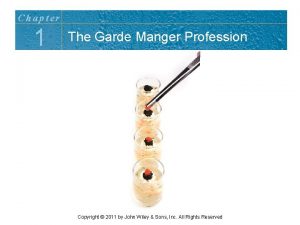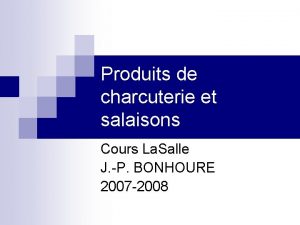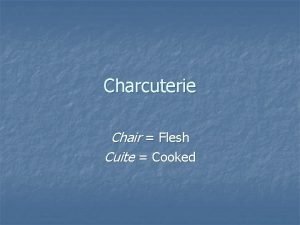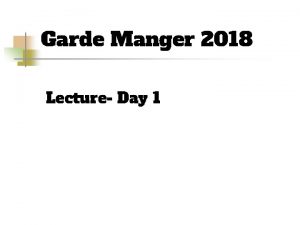Chapter 30 Charcuterie and Garde Manger Chapter 30







- Slides: 7

Chapter 30 Charcuterie and Garde Manger

Chapter 30 Objectives Define charcuterie and garde manger. n Explain what a forcemeat is. n Select and prepare ingredients, preparations, and equipment necessary to prepare a variety of forcemeats and forcemeat-based dishes. n Name and describe types of forcemeats. n Evaluate the quality of finished items prepared from forcemeats. n

Charcuterie and Garde Manger Charcuterie refers to certain foods made from pig, including sausage, smoked ham, bacon, head cheese, pates, and terrines. n Garde manger refers to the kitchen’s pantry or larder section, where foods are kept cold during etended storage and while being prepared as a cold plate. n

Forcemeats n n Forcemeats are made by grinding lean meats together with fat and seasonings to form an emulsion. There are four types of forcemeat: mousseline style, straight, country-style, and gratin. Once the ingredients for a forcemeat are ground together, they are mixed long enough to develop a smooth, unfirom, and sliceable texture. Forcemeats can be used as appetizers, stuffings, or as a component in other garde manger items, such as pates, terrines, or galantines.

Forcemeats (continued) n n n Forcemeats have three basic components: meat (provides prominent flavor and body of the forcemeat), fat (provides richness and smoothness), and seasonings (especially salt). Additional components may be required to bind the forcemeat. These may include eggs or egg whites, heavy cream, a liason, pate a choux, rice, nonfat dry milk powder, or panadas. Aspic is traditionally applied to forcemeat products to prevent them from drying out and to preserve their natural moisture and freshness.

Making Forcemeat n n Grind the meat and fat in a food processor or meat grinder. When the meat mixture is smooth, add the secondary binder, if using. Add additional ingredients as needed until the forcemeat has a smooth consistency. Push the finished forcemeat through a drum sieve before using. Adjust the seasoning or texture as needed before using. The finished forcemeat can be made into quenelles, piped into a lined mold for a terrine, or used in other preparations.

Making Quenelles n n Quenelles are poached dumplings made from forcemeat. They may be prepared to serve as an appetizer, used as a garnish for a composed dish, or used simply to test-taste a forcemeat. Bring the poaching liquid to a simmer. Shape the quenelles – the most common method used two spoons to make the signature quenelle shape. Drop the quenelles into the poaching liquid and poach until cooked through.









